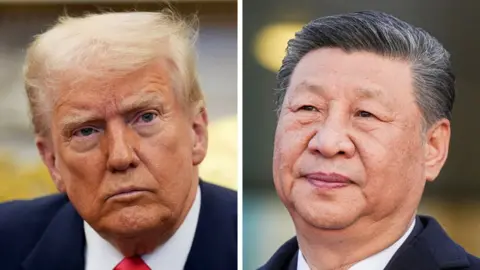**Trump’s Accusations Against China: A Deepening Trade Dispute**
In a recent development that mirrors ongoing tensions in international trade, US President Donald Trump has raised serious allegations against China, claiming that the nation has breached a recently established truce regarding tariffs. This statement came just two weeks after both nations reached a temporary agreement to reduce reciprocal tariffs following discussions that took place in Geneva. The implications of Trump’s accusations could spell a significant escalation in the already strained relations between the world’s two largest economies.
According to Trump, who made the revelations through a post on his Truth Social platform, China is facing “grave economic danger” in the wake of tariffs, which he described as part of a broader strategy to enforce a “fast deal.” However, he also asserted that China had “totally violated its agreement with us,” even though he did not specify the nature of these violations. This lack of detail quickly fuels speculation regarding the credibility and effectiveness of the truce, pending an explanation from either side regarding the alleged mishaps.
**Concerns from US Trade Representatives**
Adding another layer to the controversy, US Trade Representative Jamieson Greer echoed Trump’s concerns but provided specific details regarding China’s failure to uphold the commitments made during negotiations. Greer indicated in an interview with CNBC that China had not taken adequate steps to remove non-tariff barriers, an essential aspect of the truce that both parties had ostensibly agreed upon. As it stands, the Chinese response to these accusations remains absent, causing apprehension as the international community watches closely.
Greer elaborated that while China had rolled back some tariffs, the country had also implemented measures that restrict US businesses, such as placing certain companies on blacklists and limiting the export of rare earth materials—materials essential for various high-tech industries. “They removed the tariff like we did, but some of the countermeasures they’ve slowed on,” Greer noted, showcasing a stark contrast in how each country has approached the agreement. The US expects stricter compliance from China, expressing significant concerns over the seemingly inadequate progress on their part.
**The State of Current Trade Talks**
The complications do not end there. US Treasury Secretary Scott Bessent commented that trade talks appeared to be “a bit stalled,” reinforcing speculation that the dialogue may be losing momentum. Despite the turbulence, he remained hopeful about future talks and indicated that a communication between President Trump and Chinese President Xi Jinping could be on the horizon. Bessent emphasized the complexity of the negotiations, arguing that they would require both leaders’ direct involvement to overcome obstacles.
Compounding these issues, recent legal challenges against Trump’s tariffs have emerged, complicating his administration’s trade policies. A ruling indicated that Trump had exceeded his authority when imposing certain tariffs; however, these tariffs have been temporally reinstated following an appeal from the White House.
In a concerted effort to exert more pressure, the Trump administration took steps to revoke the visas of a substantial number of Chinese students—reportedly around 280,000—currently studying in the United States. This strategic maneuver is indicative of a broader tactic to create leverage in trade discussions, reinforcing the administration’s commitment to renegotiating terms with China.
**A Broader Economic Context**
The tariff agreement reached in mid-May sought to establish a temporary reduction in tariffs—for instance, the US lowering tariffs on Chinese goods from 145% to 30%, while China reciprocated by reducing its tariffs from 125% to 10%. Trump has long argued that tariffs on foreign imports would steer American consumers toward domestically produced goods, stimulating job creation in the manufacturing sector, and boosting tax revenues.
Amidst ongoing negotiations, a Japanese delegation is simultaneously engaged in trade talks with US officials in Washington, showcasing the complex web of international economic relations. Bessent noted that while some trade deals are nearing completion, others are more challenging, indicating a carefully orchestrated effort to navigate multifaceted negotiations on multiple fronts.
The recent court ruling affecting Trump’s tariff regime could dissuade other nations from hastily pursuing trade deals with the US. However, the federal appeals court temporarily halted the initial ruling, allowing Trump’s tariff policies to remain in effect for the time being. Trump vehemently criticized the initial decision, labeling it “horrific” and emphasizing his hope that the Supreme Court would quickly and decisively reverse it.
In conclusion, the ongoing trade tensions with China and the accusations lobbed by President Trump indicate a volatile period for international trade relations. As both nations seek to solidify their economic positions, the outcome of these disputes will have far-reaching implications, not only for the US and China but also for the global economy at large.



